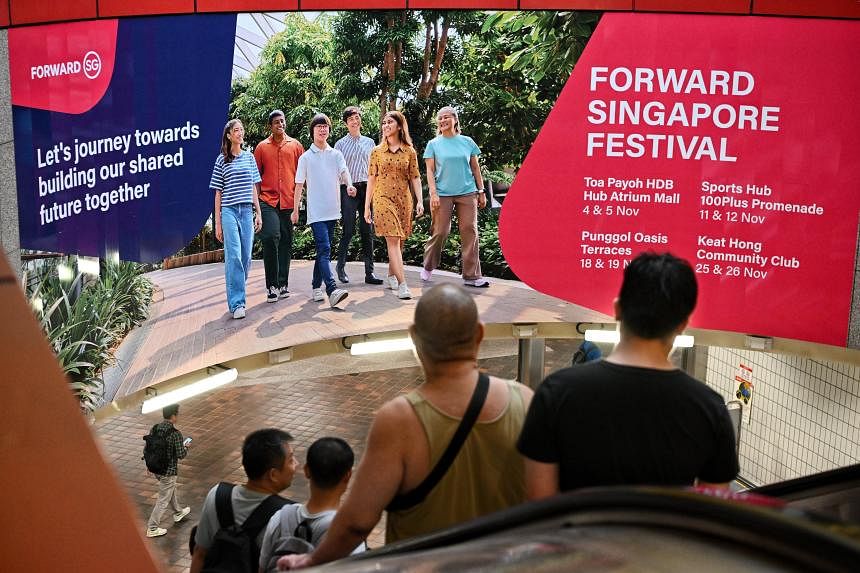Be a proud Singaporean but avoid ‘us-versus-them’ trap
Be a proud Singaporean but avoid ‘us-versus-them’ trap
A Singaporean identity has emerged. Don’t let it become a toxic one that’s resentful of foreigners.

To the casual observer, this can seem an innocuous question. Yet for two men who got into an altercation at a convenience store in 2023, it was clearly very loaded.
Security guard Namasivayam Jayapal had gone to the Cheers convenience store at Lau Pa Sat food
centre in Raffles Quay to buy some beer on the evening of Jan 1, 2023, and, making small talk, he
had asked cashier Jonathan Ong Jun Jie if he was a foreigner.
Ong bristled at the suggestion, then allegedly said that Mr Namasivayam must be from
Bangladesh and Chennai, and was therefore “under his feet”.
In the moments that followed, the police were eventually called, and Ong was later charged with
three counts of harassment.
Testifying in February 2024 after the case made its way to the courts, Mr Namasivayam said that
Ong’s insult had made him feel “very down”.
To both men, both Singaporeans, it would seem that the ultimate insult was to be labelled a
“foreigner”.
The emerging ‘Us’
Bound up in this episode is perhaps some measure of pride and, unfortunately, also prejudice
(more on this later).
While there is much to unpack about why the two men felt so slighted, there is something to be
said about their identifying strongly enough with being Singaporean, to react so strongly to the
categorisation of being a foreigner.
After all, there must be an “us” to give rise to “us-versus-them” thinking.
In close to 60 years of nation building, our national identity has been a source of uniquely
Singaporean angst. Are we Singaporean enough? Too Singaporean? Is there even a Singapore
identity? A Singaporean soul?
In the 1980s to 1990s, it was thought that such a distinct identity “had not gelled”, and as a
society and country we could not be certain that something would automatically emerge if
nothing was done.
A government committee was set up in 1989, led by now Prime Minister Lee Hsien Loong, who
was then Deputy Prime Minister, and in 1991, a White Paper was published on the core values
which all communities can hold in common.
They were: nation before community and society above self; family as the basic unit of society;
community support and respect for the individual; consensus not conflict; and racial and
religious harmony.
It was hoped the various communities would coalesce around the values and gradually develop
more common characteristics, and evolve a distinctive Singaporean identity over time.
Other similar exercises followed, such as Remaking Singapore in 2002, and Our Singapore
Conversation in 2012.
Somewhere along the way, a national identity did take shape. Its exact make-up is hard to pin
down. It may even be said to be somewhat amorphous and evolving.
But there is no doubt it exists. It is in the way no one bats an eyelid at neighbours from multi-
ethnic groups living side-by-side in harmony.
It lies in the ability to pick out another Singaporean from a crowd anywhere in the world from the
manner of their speech.
It is how Singaporeans swelled with pride when Taylor Swift’s dancer Kameron Saunders
variously uttered “no lah” or “siao ah” for her different renditions of the song We Are Never
Getting Back Together during her concert performances here. These Singlish utterances went
viral, made the news and sparked numerous comments online.
In a more complex world, the existence of a Singaporean identity has certainly been useful in
strengthening the ties that bind our communities.
For example, this identity was invoked by Minister for Foreign Affairs Vivian Balakrishnan as a
bulwark against foreign influence, in an interview with CNN during his trip to the United States
in September 2023.
Asked how seriously the Government takes reports that China is trying to influence ethnic
Chinese populations across South-east Asia, the minister had said: “I am confident that there is a
very strong sense of a Singapore identity. We may speak different languages, have different
colours. But if you come to Singapore... you will realise there is a strong sense of identity.”
“We know our identity and, most importantly, we understand what our long-term national
interests are. It is not to be anybody’s vassal state or proxy.”
More recently, he exhorted people to always “respond as Singaporeans first” when it comes to
difficult, sensitive and controversial foreign policy issues, such as the ongoing Gaza conflict that
has resonated with many here.
In an interconnected world where individuals can fall in with interest groups irrespective of
borders, the essence of being Singaporean can go some way in maintaining peace and stability in
Singapore society.
Don’t typecast ‘Them’
Yet, the altercation between Ong and Mr Namasivayam is a reminder to us that in strengthening
the “us”, we need to pay attention to the emerging “us-versus-them” dichotomy that can give rise
to xenophobia.
There is a risk of defining ourselves in relation to others – and typecasting “the other” as
somehow less able, deserving or desirable – all of which is a reductionist view that is far from the
truth.
When exploited by politicians preying on feelings of economic insecurity, solidarity at the
country level can become toxic.
Destructive forces of national populism have been unleashed in Europe, where far-right political
parties have gained power in Hungary, Italy, the Netherlands – and are gaining ground in Austria,
France, and Germany – by preying on the anxieties and grievances of those who feel they have
been left behind, while others progress.
Migration is cast as the greatest threat to national identity and migrants are blamed for
everything from crime to unemployment.
It is not inconceivable that Singapore, a society of immigrants, can be susceptible to the pulls of
such arguments.
Just look at what happened when the rapid influx of foreigners from about 2000 to 2010 stirred
resentment over competition for jobs and the strain on public infrastructure. The number of
non-resident workers grew from 612,000 to 1,113,200 – fuelled by robust economic growth amid
a shortage of local labour.
Anti-foreigner sentiment and rhetoric grew.
More recently, during a parliamentary debate on Singapore’s foreign talent policy in 2021,
Progress Singapore Party Non-Constituency MP Leong Mun Wai was accused of engaging in
“nationality-baiting” by ministers, for linking job losses and displacement here to Singapore’s
free trade agreement with India.
Needless to say, Singapore should not be allowed to descend into a society where “the other”
tends to be viewed askance and with derision.
This is especially so for a small island state that needs to look outward as a centre for
international commerce and trade, and that needs to attract talent from other shores. As a small
country lacking in natural resources, with an ageing workforce and an abysmal total fertility rate
of 0.97 recorded in 2023, Singapore has to remain open to foreigners for the economy to grow.
To prevent such sentiments from being stoked, the Government will have to continue to address
the legitimate concerns of Singaporeans.
But quite apart from economic policies, it is integral to ensure that a strong Singaporean identity
continues to be forged in various ways.
While a Singaporean identity has taken shape, the challenge is to strengthen the salubrious
aspects while shearing off the more sinister side, which can easily shade into racism and
xenophobia. This is especially difficult in an open society with many people coming and going,
and therefore keeps evolving.
As the nation forges a new social compact with Forward Singapore, emphasising compassion,
inclusivity, redefining success and enlarging the common spaces for honest conversations, there
is an opportunity for us to assess and mould our values collectively.
In doing so, it would be useful to think about the outcomes.
While a sense of introspection and history is good and should be encouraged, I think it would be
important to remember to look outwards rather than only inwards, and look forward – to the
future and where the world is going – rather than backward, in terms of how things used to be.
And by doing so, we can embrace a narrative centred on unity and progress.
To borrow our Singlish words back from Mr Saunders the dancer, the test of whether we have
arrived would be when someone asks a Singaporean if he is a foreigner, and the response that
comes without skipping a beat is simply, “no lah”.
